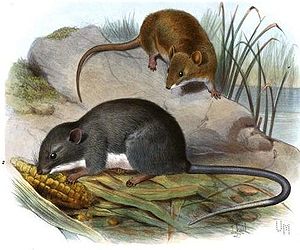Climbing rats
| Climbing rats | ||||||||||||
|---|---|---|---|---|---|---|---|---|---|---|---|---|

Oryzomys couesi (above) and Tylomys panamensis |
||||||||||||
| Systematics | ||||||||||||
|
||||||||||||
| Scientific name | ||||||||||||
| Tylomys | ||||||||||||
| Peters , 1866 |
The climbing rats ( Tylomys ) are a genus of rodents from the New World mouse group that lives in Central and Northern South America . It includes seven types.
Climbing rats reach a head body length of 17 to 26 centimeters, the tail becomes 20 to 25 centimeters long. The weight is only known for the species T. nudicaudus , which weighs around 280 grams. The fur is colored reddish, brown or black-gray on the upper side depending on the species, the belly is white or yellow. The long tail is sparsely hairy, the large ears are bare. The short, wide hind feet are adapted to a tree-dwelling way of life.
The range of the climbing rats extends from southern Mexico to Colombia and northern Ecuador . They are pronounced forest inhabitants and are likely to live at least partially on trees, but animals have also been found on rocks. Otherwise little is known about the way of life.
There are seven types:
- Tylomys bullaris is known from only one location in the Mexican state of Chiapas . The species is listed by the IUCN as " critically endangered ".
- Tylomys fulviventer lives exclusively in eastern Panama .
- Tylomys mirae occurs in western Colombia and northwestern Ecuador and is therefore the only South American representative of this group.
- Tylomys nudicaudus is distributed from southern Mexico to Nicaragua .
- Tylomys panamensis lives exclusively in eastern Panama. According to the IUCN, the species is endangered ( vulnerable ).
- Tylomys tumbalensis is only found in the Mexican state of Chiapas. This species is also listed as "critically endangered".
- Tylomys watsoni is common in Costa Rica and Panama.
The closest relative of the climbing rats is the big-eared climbing rat , otherwise they are largely isolated in the New World mice system. They are classified in the subfamily of the Tylomyinae .
literature
- Ronald M. Nowak: Walker's Mammals of the World. 2 volumes. 6th edition. Johns Hopkins University Press, Baltimore MD et al. 1999, ISBN 0-8018-5789-9 .
- Don E. Wilson , DeeAnn M. Reeder (Eds.): Mammal Species of the World. A taxonomic and geographic Reference. 2 volumes. 3. Edition. Johns Hopkins University Press, Baltimore MD 2005, ISBN 0-8018-8221-4 .
Web links
- Endangerment level of the individual species in the IUCN Red List of Threatened Species .